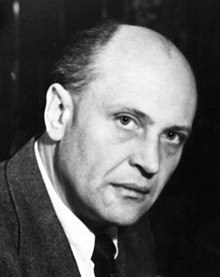Herbert Säverin
Herbert Säverin (born September 23, 1906 in Zapel , † May 23, 1987 in Berlin ) was Lord Mayor of Wismar from 1945 to 1950 .
Life
Until 1945
Herbert Säverin was born on September 23, 1906 in Zapel (Mecklenburg) as the son of a line worker and a washerwoman. In 1918 he was given a job at the secondary school in Wismar and in 1923 joined the Wismar city administration as an apprentice, where he worked until he was released in 1933. In 1934 he married Hildegard Grambow, who bore him three children by 1942. From 1933 to 1945 the family ran a tobacco shop in Wismar. Herbert Säverin was drafted in 1939 and taken prisoner of war in May 1945 as a sergeant of the Wehrmacht in Carinthia (Austria). On June 16, 1945 he was released to Wismar.
Herbert Säverin joined the SPD in 1922 , the Reichsbanner Schwarz-Rot-Gold in 1924 and the “ Iron Front ” in 1931 and was a city councilor for the SPD in 1932 and 1933 in Wismar.
1945 to 1950
Herbert Säverin worked again in the Wismar city administration from July 3, 1945, where he initially headed the Internal Affairs Department and was appointed Lord Mayor of Wismar on December 16, 1945 in agreement with the Soviet military administration . December 1950 worked. With the founding of the SED in April 1946, he became a member and later appointed to the secretariat of the district party leadership.
During this time, the city administration of Wismar worked to improve the housing situation in the partially destroyed city, to secure the supply of the population with food and public services and to get the local economy going.
Before the war, Wismar was a town with around 30,000 inhabitants. In 1946, after taking in 12,000 resettlers, it had over 40,000 inhabitants. A fifth of the residential structure was badly damaged or destroyed by bombs, and the Red Army occupied 3,900 rooms in undamaged houses . To counter the housing shortage, the city administration began to have residential buildings repaired in the summer of 1945 and achieved that after a year 800 slightly damaged apartments could be moved into again. In the following years, despite the general shortage of building materials, the city administration succeeded in reconstructing the residential buildings that were still usable and in cleaning up the bomb holes so that new buildings could be built on them.
The food situation was initially precarious. It was not until the first quarter of 1946 that all of the rations on the food cards could be given out. Before the war, 9,000 allotment gardens and small fields were used to grow fruit and vegetables. These agricultural areas were put back into use in 1945, whereby the city administration obtained permission from the military administration to set up a self-protection organization with police authority to protect the gardens and fields from theft by the population.
Before the war, Wismar owned a small port of more regional importance, which was largely destroyed by bombs. Since Germany only had three Baltic Sea ports after the war, the military administration and the city administration decided to expand the Wismar port into an important transshipment port for Mecklenburg and for the export of reparations goods . The former small repair yard was expanded into a modern large yard with 5000 jobs by 1950. The city administration ensured that medium-sized companies such as a printing company and a sawmill settled in Wismar, that the former Dornier aircraft yard became the Wismar structure with 200 jobs and the wagon factory resumed production. In 1946 peat was extracted as fuel for the townspeople.
In addition, a local transport network was put into operation by 1950 and a new venue was created for the city theater that burned down in 1948 . The newly established kindergartens, which made it easier for the many single women to work, also became important for the economic development. The project of an Elbe-Baltic Sea Canal to connect Wismar to the inland waterway network, operated by Herbert Säverin, was ultimately not realized.
After 1950
After his work as Lord Mayor, Herbert Säverin headed the Schwerin district administration of the trade organization and passed a state examination in "domestic trade" at the Academy for Political Science and Law . In 1954 Herbert Säverin moved to Berlin and joined the Ministry of Trade and Supply. There he was temporarily head of department and most recently a research assistant until the retirement age in 1971.
literature
- Nitschke, K .; Duesing, A .: Wismar. History and face of a city. Brockhaus, Leipzig 1964
- Seidler, K.-H .; Werdenel, W .: On the right course. Contemporary stories from the development of fleets and ports. Ostsee-Druck, Wismar 1984
- SED-Stadtleitung Wismar [Hrsg.]: Contributions to the history of the Wismar workers' movement. Schwerin 1977
- Chronicle of the SED district leadership Wismar. Part I-IV
swell
- Curriculum vitae Herbert Säverin (Wismar city archive, signature: 2.2.2.4. Serial no. 97)
- Herbert Säverin's estate (family property)
Web links
| personal data | |
|---|---|
| SURNAME | Säverin, Herbert |
| BRIEF DESCRIPTION | German local politician, Lord Mayor of Wismar |
| DATE OF BIRTH | September 23, 1906 |
| PLACE OF BIRTH | Zapel |
| DATE OF DEATH | May 23, 1987 |
| Place of death | Berlin |
